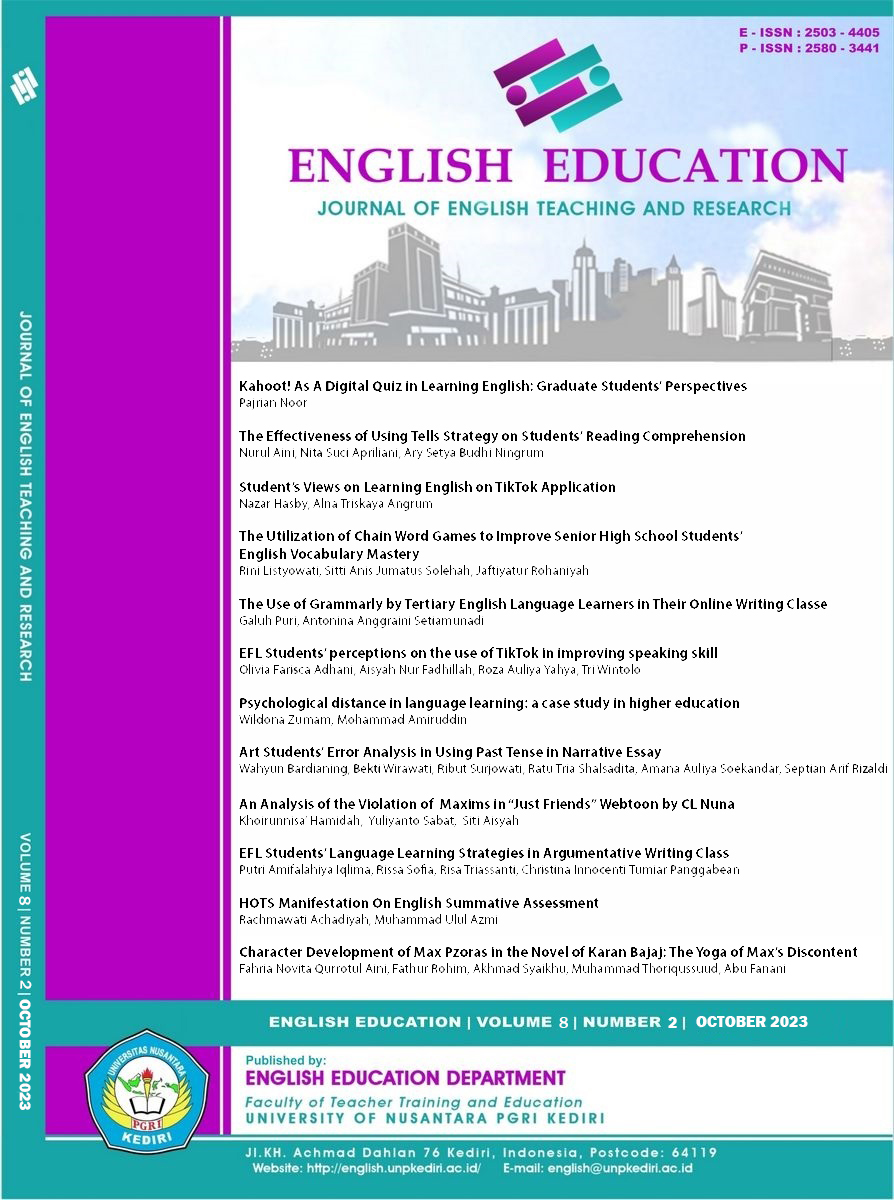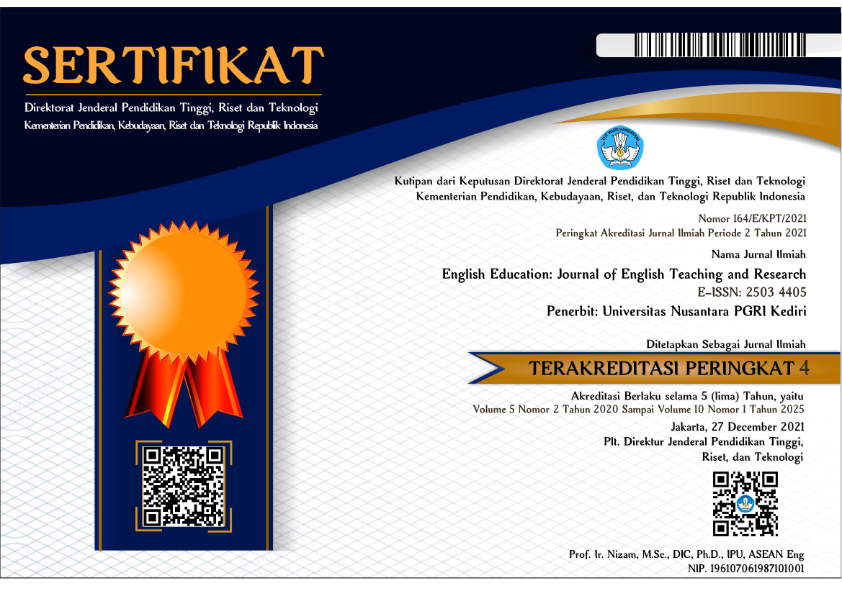Hots Manifestation in English Summative Assessment
DOI:
https://doi.org/10.29407/jetar.v8i2.20915Keywords:
HOTS, English Summative, English assessmentAbstract
Higher-order thinking gains a positive role in language assessment since it is compulsory to be implemented in the teaching-learning and evaluation system of the latest curriculum. The implementation of HOTS in English tests assists students in practicing their analytical, critical, and problem-solving skills in real life. It is essential to know how the hots question is narrated in English summative assessment. Myriad research has examined the thinking level applied in English summative tests. However, there has been less previous evidence for portraying how the hots questions were being narrated. This study specifically employed a case study as a research design with content analysis as the technique to analyze the data. Three papers of the English summative test of the first, second, and third grades of junior high school became the source of the data. The result highlighted that the ninth-grade English summative test applied higher-order thinking in 72% of both multiple choice and essay. The thinking levels used are giving a solution, giving a recommendation, giving an opinion, making judgments, and interpreting. This study discovered how English teachers also, as the test designers, formulate hots questions in English summative tests.
Downloads
References
Afriadi, R. (2021). Implementation of Levels of Thinking Skills and Communicative Language. 5(2019), 57–68.
Ariffin, K., Muhamad, A., Zamri, L., Liza, N., & Kadir, A. (2015). An investigation of the frequency of HOT and LOT of Bloom taxonomy in the diploma English entrance exam. The Asian Journal of English Language & Pedagogy ISSN, 3, 228–241.
Bowen, G. A. (2009). Document analysis as a qualitative research method. Qualitative Research Journal, 9(2), 27–40. https://doi.org/10.3316/QRJ0902027
chanda, armstrong. (2022). Key Methods Used in Qualitative Document Analysis. SSRN Electronic Journal, 1990, 1–9. https://doi.org/10.2139/ssrn.3996213
Clemmensen, L. H., Sliusarenko, T., Christiansen, B. L., & Ersbøll, B. K. (2013). Effects of mid-term student evaluations of teaching as measured by end-of-term evaluations: An emperical study of course evaluations. CSEDU 2013 - Proceedings of the 5th International Conference on Computer Supported Education, September 2016, 303–310. https://doi.org/10.5220/0004353503030310
Fitriani, D. H., & Kirana, D. P. (2022). Higher Order Thinking Skill (Hots) in English Language Textbook in Senior High School. International Journal of Research on English Teaching and Applied Linguistics, 2(2), 55–66. https://doi.org/10.30863/ijretal.v2i2.2455
Frank, J. (2012). The roles of assessment in language teaching. English Teaching Forum, 32. https://files.eric.ed.gov/fulltext/EJ997527.pdf
Hatipoğlu, Ç. (2010). Summative evaluation of an English language testing and evaluation course for future English language teachers in Turkey. Elted, 13(December 2010), 40–51.
Indriati, T. (2011). EDUCATIVE ASSESSMENT IN ENGLISH LANGUAGE TEACHING by THE GRADUATE PROGRAM IN ENGLISH LANGUAGE STUDIES.
Kebangsaan Malaysia, U., & Majid Khan Rana, A. (2020). Exploring Summative Assessment and Effects: Primary to Higher Education Serious game engagement’s model View project Virtual Museum View project Kashif Ishaq. March 2021. https://www.researchgate.net/publication/350353443
Keus, K., Grunwald, J., & Haave, N. (2019). A method to the midterms: The impact of a second midterm on students’ learning outcomes. Bioscene, 45(1), 3–8.
Kurniawan, A. (2020). The Barriers in Integrating Higher Order Thinking Skills in Indonesia Context. Jurnal Bahasa & Sastra, 20(2), 139–144.
Kurniawati, S., & Sundawa, D. (2019). An Analysis of National Standard School Examination Items Based on the Characteristics of Hots (Higher Order Thinking Skills) Questions for the Main Items of K13-071 Academic Year 2016/2017 in Karawang Regency. International Journal Pedagogy of Social Studies, 3(2), 100–112.
Nurhatmanti, R., Lian, B., & Dedy, A. (2021). Analysis of Students’ Higher Order Thinking Skills (HOTS) in Natural Science Subjects Class V Elementary School. Indonesian Journal of Primary Education, 5(2), 208–213. https://doi.org/10.17509/ijpe.v5i2.37107
Pratiwi, N. P. W., Dewi, N. L. P. E. S., & Paramartha, A. A. G. Y. (2019). The Reflection of HOTS in EFL Teachers’ Summative Assessment. Journal of Education Research and Evaluation, 3(3), 127. https://doi.org/10.23887/jere.v3i3.21853
Santy, N. P. L., Dewi, N. L. P. E. S., & Paramartha, A. A. G. Y. (2020). the Quality of Teacher-Made Multiple-Choice Test Used As Summative Assessment for English Subject. Prasi, 15(02), 57. https://doi.org/10.23887/prasi.v15i02.25560
Saptuti Susiani, T., Salimi, M., & Hidayah, R. (2018). Research Based Learning (RBL): How to Improve Critical Thinking Skills? SHS Web of Conferences, 42, 00042. https://doi.org/10.1051/shsconf/20184200042
States, J., Detrich, R., & Keyworth, R. (2018). Summative Assessment (Wing Institute Original Paper). Undefined, March. https://doi.org/10.13140/RG.2.2.16788.19844
Svendsen, B. A. (2015). Language, youth and identity in the 21st century: Content and continuations. Language, Youth and Identity in the 21st Century: Linguistic Practices Across Urban Spaces, Appadurai 1990, 3–23. https://doi.org/10.1017/CBO9781139061896.002
Syahdanis, J. D., Sofyan, D., & Yunita, W. (2021). Analysis of Hots in English Teacher-Made Test. Jurnal Basis, 8(2), 203–216. https://doi.org/10.33884/basisupb.v8i2.4479
Tosuncuoglu, I. (2018). Importance of Assessment in ELT. Journal of Education and Training Studies, 6(9), 163. https://doi.org/10.11114/jets.v6i9.3443
Yin, R. K. (2018). Case study research and applications: Design and methods. In Journal of Hospitality & Tourism Research (Vol. 53, Issue 5). https://doi.org/10.1177/109634809702100108
Yuliati, S. R., & Lestari, I. (2018). Higher-Order Thinking Skills (Hots) Analysis of Students in Solving Hots Question in Higher Education. Perspektif Ilmu Pendidikan, 32(2), 181–188. https://doi.org/10.21009/pip.322.10
Downloads
Published
Issue
Section
License
Authors who publish with this journal agree to the following terms:
- Copyright on any article is retained by the author(s).
- The author grants the journal, the right of first publication with the work simultaneously licensed under a Creative Commons Attribution License that allows others to share the work with an acknowledgment of the work’s authorship and initial publication in this journal.
- Authors are able to enter into separate, additional contractual arrangements for the non-exclusive distribution of the journal’s published version of the work (e.g., post it to an institutional repository or publish it in a book), with an acknowledgment of its initial publication in this journal.
- Authors are permitted and encouraged to post their work online (e.g., in institutional repositories or on their website) prior to and during the submission process, as it can lead to productive exchanges, as well as earlier and greater citation of published work.
- The article and any associated published material is distributed under the Creative Commons Attribution-ShareAlike 4.0 International License








 Article template
Article template



